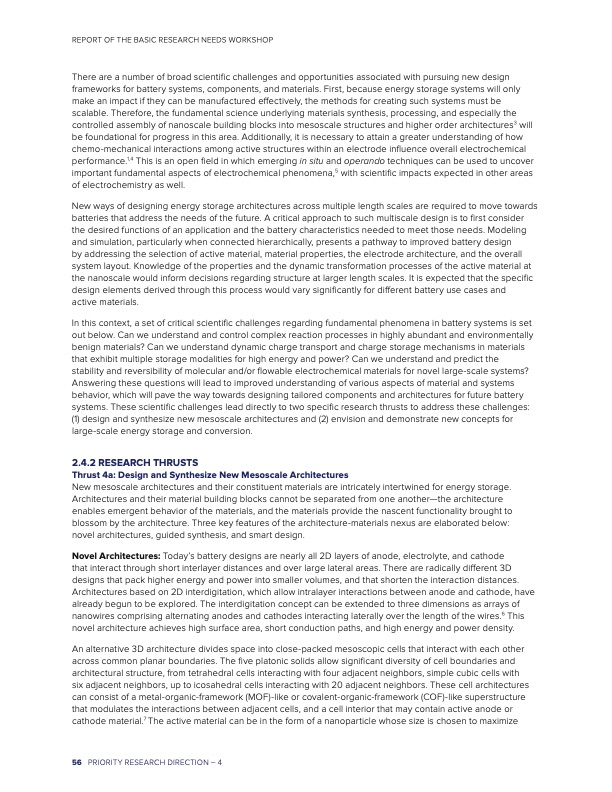
PDF Publication Title:
Text from PDF Page: 062
REPORT OF THE BASIC RESEARCH NEEDS WORKSHOP There are a number of broad scientific challenges and opportunities associated with pursuing new design frameworks for battery systems, components, and materials. First, because energy storage systems will only make an impact if they can be manufactured effectively, the methods for creating such systems must be scalable. Therefore, the fundamental science underlying materials synthesis, processing, and especially the controlled assembly of nanoscale building blocks into mesoscale structures and higher order architectures3 will be foundational for progress in this area. Additionally, it is necessary to attain a greater understanding of how chemo-mechanical interactions among active structures within an electrode influence overall electrochemical performance.1,4 This is an open field in which emerging in situ and operando techniques can be used to uncover important fundamental aspects of electrochemical phenomena,5 with scientific impacts expected in other areas of electrochemistry as well. New ways of designing energy storage architectures across multiple length scales are required to move towards batteries that address the needs of the future. A critical approach to such multiscale design is to first consider the desired functions of an application and the battery characteristics needed to meet those needs. Modeling and simulation, particularly when connected hierarchically, presents a pathway to improved battery design by addressing the selection of active material, material properties, the electrode architecture, and the overall system layout. Knowledge of the properties and the dynamic transformation processes of the active material at the nanoscale would inform decisions regarding structure at larger length scales. It is expected that the specific design elements derived through this process would vary significantly for different battery use cases and active materials. In this context, a set of critical scientific challenges regarding fundamental phenomena in battery systems is set out below. Can we understand and control complex reaction processes in highly abundant and environmentally benign materials? Can we understand dynamic charge transport and charge storage mechanisms in materials that exhibit multiple storage modalities for high energy and power? Can we understand and predict the stability and reversibility of molecular and/or flowable electrochemical materials for novel large-scale systems? Answering these questions will lead to improved understanding of various aspects of material and systems behavior, which will pave the way towards designing tailored components and architectures for future battery systems. These scientific challenges lead directly to two specific research thrusts to address these challenges: (1) design and synthesize new mesoscale architectures and (2) envision and demonstrate new concepts for large-scale energy storage and conversion. 2.4.2 RESEARCH THRUSTS Thrust 4a: Design and Synthesize New Mesoscale Architectures New mesoscale architectures and their constituent materials are intricately intertwined for energy storage. Architectures and their material building blocks cannot be separated from one another—the architecture enables emergent behavior of the materials, and the materials provide the nascent functionality brought to blossom by the architecture. Three key features of the architecture-materials nexus are elaborated below: novel architectures, guided synthesis, and smart design. Novel Architectures: Today’s battery designs are nearly all 2D layers of anode, electrolyte, and cathode that interact through short interlayer distances and over large lateral areas. There are radically different 3D designs that pack higher energy and power into smaller volumes, and that shorten the interaction distances. Architectures based on 2D interdigitation, which allow intralayer interactions between anode and cathode, have already begun to be explored. The interdigitation concept can be extended to three dimensions as arrays of nanowires comprising alternating anodes and cathodes interacting laterally over the length of the wires.6 This novel architecture achieves high surface area, short conduction paths, and high energy and power density. An alternative 3D architecture divides space into close-packed mesoscopic cells that interact with each other across common planar boundaries. The five platonic solids allow significant diversity of cell boundaries and architectural structure, from tetrahedral cells interacting with four adjacent neighbors, simple cubic cells with six adjacent neighbors, up to icosahedral cells interacting with 20 adjacent neighbors. These cell architectures can consist of a metal-organic-framework (MOF)-like or covalent-organic-framework (COF)-like superstructure that modulates the interactions between adjacent cells, and a cell interior that may contain active anode or cathode material.7 The active material can be in the form of a nanoparticle whose size is chosen to maximize 56 PRIORITY RESEARCH DIRECTION – 4PDF Image | Next Generation Electrical Energy Storage

PDF Search Title:
Next Generation Electrical Energy StorageOriginal File Name Searched:
BRN-NGEES_rpt-low-res.pdfDIY PDF Search: Google It | Yahoo | Bing
Sulfur Deposition on Carbon Nanofibers using Supercritical CO2 Sulfur Deposition on Carbon Nanofibers using Supercritical CO2. Gamma sulfur also known as mother of pearl sulfur and nacreous sulfur... More Info
CO2 Organic Rankine Cycle Experimenter Platform The supercritical CO2 phase change system is both a heat pump and organic rankine cycle which can be used for those purposes and as a supercritical extractor for advanced subcritical and supercritical extraction technology. Uses include producing nanoparticles, precious metal CO2 extraction, lithium battery recycling, and other applications... More Info
| CONTACT TEL: 608-238-6001 Email: greg@infinityturbine.com | RSS | AMP |